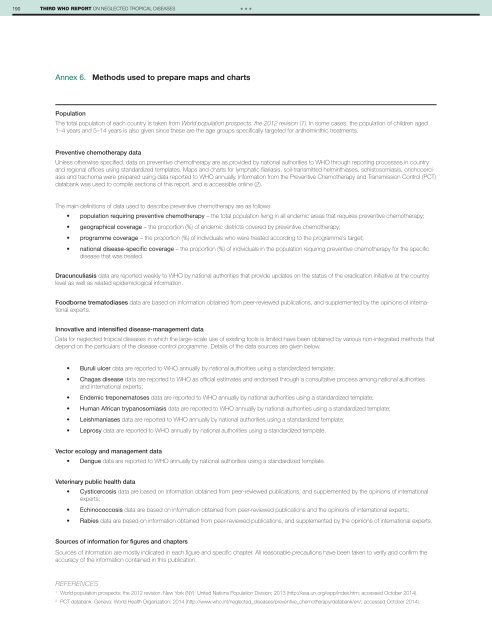1A9bnbK
1A9bnbK
1A9bnbK
Create successful ePaper yourself
Turn your PDF publications into a flip-book with our unique Google optimized e-Paper software.
190 THIRD WHO REPORT ON NEGLECTED TROPICAL DISEASES<br />
***<br />
Annex 6. Methods used to prepare maps and charts<br />
Population<br />
The total population of each country is taken from World population prospects: the 2012 revision (1). In some cases, the population of children aged<br />
1–4 years and 5–14 years is also given since these are the age groups specifi cally targeted for anthelminthic treatments.<br />
Preventive chemotherapy data<br />
Unless otherwise specifi ed, data on preventive chemotherapy are as provided by national authorities to WHO through reporting processes in country<br />
and regional offi ces using standardized templates. Maps and charts for lymphatic fi lariasis, soil-transmitted helminthiases, schistosomiasis, onchocerciasis<br />
and trachoma were prepared using data reported to WHO annually. Information from the Preventive Chemotherapy and Transmission Control (PCT)<br />
databank was used to compile sections of this report, and is accessible online (2).<br />
The main defi nitions of data used to describe preventive chemotherapy are as follows:<br />
• population requiring preventive chemotherapy – the total population living in all endemic areas that requires preventive chemotherapy;<br />
• geographical coverage – the proportion (%) of endemic districts covered by preventive chemotherapy;<br />
• programme coverage – the proportion (%) of individuals who were treated according to the programme’s target;<br />
• national disease-specific coverage – the proportion (%) of individuals in the population requiring preventive chemotherapy for the specifi c<br />
disease that was treated.<br />
Dracunculiasis data are reported weekly to WHO by national authorities that provide updates on the status of the eradication initiative at the country<br />
level as well as related epidemiological information.<br />
Foodborne trematodiases data are based on information obtained from peer-reviewed publications, and supplemented by the opinions of international<br />
experts.<br />
Innovative and intensified disease-management data<br />
Data for neglected tropical diseases in which the large-scale use of existing tools is limited have been obtained by various non-integrated methods that<br />
depend on the particulars of the disease-control programme. Details of the data sources are given below.<br />
• Buruli ulcer data are reported to WHO annually by national authorities using a standardized template;<br />
• Chagas disease data are reported to WHO as offi cial estimates and endorsed through a consultative process among national authorities<br />
and international experts;<br />
• Endemic treponematoses data are reported to WHO annually by national authorities using a standardized template;<br />
• Human African trypanosomiasis data are reported to WHO annually by national authorities using a standardized template;<br />
• Leishmaniases data are reported to WHO annually by national authorities using a standardized template;<br />
• Leprosy data are reported to WHO annually by national authorities using a standardized template.<br />
Vector ecology and management data<br />
• Dengue data are reported to WHO annually by national authorities using a standardized template.<br />
Veterinary public health data<br />
• Cysticercosis data are based on information obtained from peer-reviewed publications, and supplemented by the opinions of international<br />
experts;<br />
• Echinococcosis data are based on information obtained from peer-reviewed publications and the opinions of international experts;<br />
• Rabies data are based on information obtained from peer-reviewed publications, and supplemented by the opinions of international experts.<br />
Sources of information for figures and chapters<br />
Sources of information are mostly indicated in each fi gure and specifi c chapter. All reasonable precautions have been taken to verify and confi rm the<br />
accuracy of the information contained in this publication.<br />
REFERENCES<br />
1<br />
World population prospects: the 2012 revision. New York (NY): United Nations Population Division; 2013 (http://esa.un.org/wpp/index.htm; accessed October 2014).<br />
2<br />
PCT databank. Geneva: World Health Organization; 2014 (http://www.who.int/neglected_diseases/preventive_chemotherapy/databank/en/; accessed October 2014).


